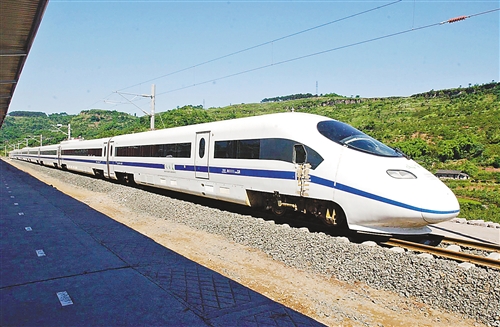2012 RUC China Development Index shows public confidence in country’s development

The world’s longest high speed line, the Beijing-Guangzhou rail route, was officially opened on December 26, 2012.
The 2012 edition of RUC China Development Index (RCDI) was released by the National Survey Research Center (NSRC) at Renmin University of China on December 22. The report indicated that Beijing, Shanghai and Tianjin are among the top three cities in terms of all indexes.
Notably, 2012 marks the first year that RCDI includes statistics on citizens’ confidence in the development of China. Results show that those surveyed have strong confidence in China’s future development.
RCDI consists of a health index, education index, quality of life index and social environment index with altogether 15 indicators. Since it was first released in 2005, RCDI has been compiled from the previous years’ statistics by sector on a national level. In this year’s edition, 31 provincial administrative regions were measured and ranked based on statistics from 2011. Compared with 2009 and 2010, all indexes continued to increase, and Beijing remained first for the third straight year. When considering sub-indexes for the 31 regions, little change occurred in sequence for the health index, quality of life index and social environment index compared with 2010, while the majority of regions saw improvement in the in education index compared to 2009 and 2010.
Experts say that China development index and the sub-indexes have seen impressive growth for seven years ever since 2005, which is indicative of the steady overall socioeconomic development of China. The year on year comparison has witnessed generally balanced growth in the eastern, western and central regions of China; however, the specifics of what growth encompasses vary between regions.
The report says that there have always been regional divergences for RDCI, and the gap has been widening in terms of the general socioeconomic development. It links this widening as being generated by the increasing gap in the quality of life index. The social environment index has seen the smallest difference and kept steady, and differences in health index and education index have been narrowed this year.
“The regional gap in terms of general socioeconomic development has been widening, mainly because of the development status indicated by quality of life index, while changes in social environment have exerted minor influence,” said Peng Fei, deputy director of NSRC.“The quality of life index has been increasing during all these years in various regions. Its growth is the fastest, while the gap between regions is also the largest and fastest-growing.”
NSRC conducted the investigation on people’s confidence in the mainland’s development in 2012 through computer assisted telephone interview (CATI). The survey samples were randomly selected using the same sampling template as is used by the China General Social Survey (CGSS). On the whole, those interviewed have great confidence in the prospect of China, with 45% saying they are very confident and 26% reporting they are rather confident. The results show the dramatic progress made in transportation and medical care, while also indicating the apprehension about the environment, education and the gap between the rich and the poor. From the perspective of location, people from the super metropolitan areas are the least confident in prospects for the future while those in the medium-level regions have notably more faith than people from other parts.
“The survey into the public’s confidence in development is, to a certain extent, indicative of how happy people are as well as the development of spiritual culture. Chinese citizen’s confidence in their country’s development is a significant support-base for the sense of happiness in the whole society,” said Yuan Wei, former senior vice president of Renmin University of China. Yuan also asserted that quality of development and people’s livelihood have continuously been the focuses of RCDI. He noted that the index has not only provided an analysis of the development situation from the perspective of the economy, society and the environment, but has also surveyed people’s feelings toward development, offering reference material based on subjective and objective measures for both academia and the government alike.
Huo wenqi is a reporter from the Chinese Social Sciences Today.
The Chinese version appeared in Chinese Social Sciences Today, No. 396, Dec. 24.
(Translated by Jiang Hong)
Chinese link:
